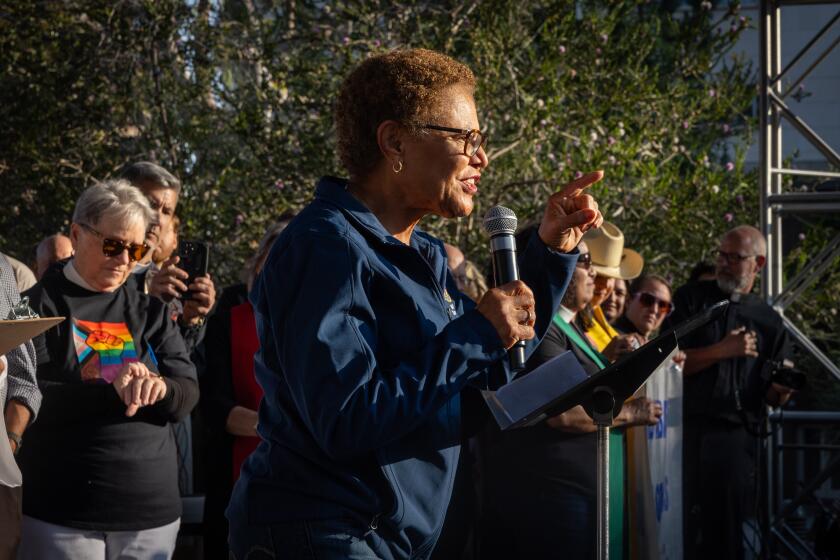Birds of an Oily Feather : Environment: Workers at a makeshift hospital treat and scrub frightened wildlife coated with black goo from the Santa Clara River spill.
- Share via
The patients arrived unceremoniously, five or six in a plain, brown carton. They huddled together quietly, smelling like the La Brea tar pits and looking pathetic in a heavy coating of thick, black goo.
Immediately, the hospital crew selected one, wrapped it in a towel and brushed a leg with alcohol, revealing iridescent greenish skin. A few drops of blood were drawn to determine the health of the frightened creature.
The birds had arrived at the makeshift hospital room set up at Terminal Island, the first stop on the road to recovery for wildlife coated with San Joaquin heavy crude oil when a Mobil Oil Corp. pipeline burst Feb. 1, affecting the Santa Clara River.
As volunteers and staff working for the Berkeley-based International Bird Rescue and Research Center set about their tasks one day last week, many recalled where they had been a year ago: cleaning more than 1,000 sea birds affected by the Huntington Beach oil spill.
Soon after the center’s Mimi Wood was notified of the latest spill, calls went out to volunteers as well as some of the 25 on-call staff members. Nine flew in from as far away as Alaska, Seattle, Canada and even West Germany. Their expenses will be paid by Mobil.
As of Thursday night, 131 animals had arrived, mostly mallards, widgeons and coots, along with a heron, a hawk and a muskrat. The yellow bills of the mallards had the patina of a well-oiled maple cabinet. There was not a hint of the glory of their coloring or of the intricacy of the widgeons’ speckled brown, black and white feathers. Twenty-five birds had already died at the center.
For each animal, the ordeal began with a blood test and medication. Each received a dose of Toxiban, a charcoal mixture to filter any oil they’d ingested, and a rehydration solution of Pedialite, which Wood said is like Gatorade without the color and sugar. “We make the gross assumption that they’re dehydrated from ingesting crude oil,” she said.
If a blood test showed a low red-blood cell count, the bird was placed in a hospital pen to be nursed until its condition improved.
Workers recalled a coot that arrived with a special note from the search and rescue team at the spill site: “Want extra fluids given to bird because it was really depressed at the time he was caught.”
If the blood count was good, the bird was taken to the heated “dirty bird room” for one or two days rest before undergoing the stressful process of cleaning. The room held 17 wooden pens, each covered by an old sheet or two to keep the birds from flying out.
During a visit one morning last week, the room was oddly quiet. A careful listener could hear the ducks lapping up a mixture of chicken mash and water put in each pen a few times a day.
“They’re eating,” said Wood, who can imitate the sound of a duck lapping mash. “That’s encouraging. They’re comfortable.”
In the far corner, staff and volunteers were making the rounds with plastic bottles of Pedialite solution or gruel that had to be fed directly to each bird’s stomach with a long skinny catheter attached to a plastic syringe the width of those in a bad nightmare.
None of the birds exhibited outward signs of distress, but to a seasoned observer, their silence spoke volumes. “They think we’re predators,” Wood said, “and they’re scared out of their wits.” If they squawked, she said, they would draw more attention to their vulnerable condition.
The cleaning was done by two-worker teams who donned floor-length transparent plastic bags, boots and shoulder-length gloves. They worked with three-gallon plastic tubs containing water warmed to between 100 and 108 degrees.
A widgeon was brought swaddled in a towel. One worker held its bill closed and the other submerged its body in a tub and scrubbed vigorously. The cleanser of choice? Dawn dish-washing detergent, whose label promises it is “effective on grease.”
Water sloshed everywhere. The contents of the tub turned black quickly and the duck was moved to a second tub, where the scrubbing resumed. Workers sometimes used a toothbrush or Water Pik device to clean the head and around the eyes.
Each time the water grew dirty, the bird was moved again until finally, after about 10 such transfers, the cleaning was complete. The bird then was handed to two workers in the next room who sprayed it with high-speed water jets to remove soap residue, which prevents feathers from aligning properly to waterproof the bird.
The widgeon was turned upside down so that its stomach could be rinsed. The bird offered no resistance, but its webbed feet trembled furiously.
A mallard or widgeon can withstand 45 minutes of the washing process, Wood said. A coot reaches its limit after 25 minutes. After that, the stress becomes too great.
“They have hot water on top of them and humans in their face,” Wood said. “It’s like they have little heart attacks. When they go limp, you try to shake them pretty quick and they come back.”
After cleaning, the birds were placed in pens that had blow-dryers underneath. They began to look like Audubon drawings: the mallards, elegant with their purple wing tips, white chests, iridescent green heads and yellow bills; the widgeons resembling fine Florentine endpapers.
Wood said most of the badly exposed birds have to be washed again, but not for a few days. After that, they will be placed in an outdoor pool constructed on-site to test for waterproofing. If they stay afloat and their feathers do not absorb water after four or five days, they can be released at a spot determined with the state Department of Fish and Game.
Then, according to volunteer David Thraen, comes the good part. “You get to let them go.”
HOW BIRDS ARE BATHED 1. A technician tests blood to gauge the bird’s general health and tolerance for washing. Sick, anemic and dehydrated birds must be treated before being washed.
2. The bird is dipped in a solution of Dawn dish detergent and water at 100 to 108 degrees. One person holds the bill closed as another massages water into the feathers. The head and eye area are washed with a soft toothbrush.
3. The bird is moved quickly from tub to tub as the water gets dirty. Ten to 15 tubs are common.
4. When the water is clear and free of oil, the bird is rinsed with warm water from a high-powered nozzle. This removes soap residue and helps align the feathers, which is essential for waterproofing.
5. The bird is blow-dried in a net-bottomed pen.
6. A few days later, the bird is examined for oil. If clean, it is placed in a pool of water. If fully clean and waterproof, it stays for four or five days until its release. Many need rewashing, however.
More to Read
Sign up for Essential California
The most important California stories and recommendations in your inbox every morning.
You may occasionally receive promotional content from the Los Angeles Times.













